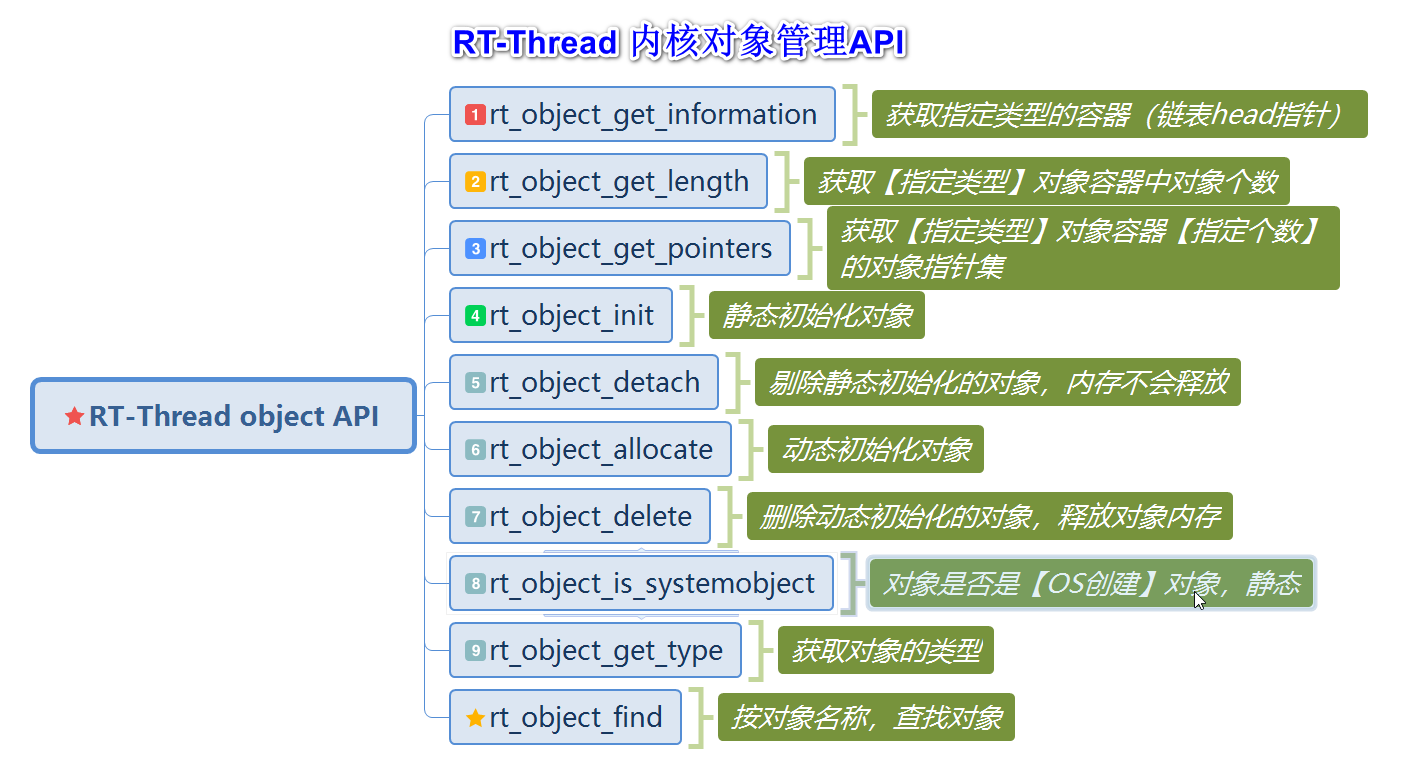这期内容当中小编将会给大家带来有关RT-Thread中的内核对象操作API怎么理解,文章内容丰富且以专业的角度为大家分析和叙述,阅读完这篇文章希望大家可以有所收获。
目的还是学习并熟悉RT-Thread 操作系统。
从最简单的对象管理切入
了解操作系统最基本的组成单位:Object
内核对象的主要操作方法:内核文件:object.c中实现

查看内核文件:object.c,发现的主要的几个知识点
光看内核代码,不如敲一敲(抄一下)。
可以使用模拟器,写几个测试函数,看看对象操作的流程。
测试用例如下:
/* RT-Thread 内核对象学习 */
#include <rtthread.h>
struct _obj_type
{
enum rt_object_class_type type;
const char* name;
};
/* 静态的对象定义 */
static struct rt_object _obj[] = { 0 };
/* 测试用,线程对象 */
static const struct _obj_type _obj_tbl[] =
{
{ RT_Object_Class_Thread, "th_01" },
{ RT_Object_Class_Thread, "th_02" },
{ RT_Object_Class_Thread, "th_03" },
{ RT_Object_Class_Thread, "th_04" },
{ RT_Object_Class_Thread, "th_05" },
};
#define OBJ_TEST_TBL_SIZE (sizeof(_obj_tbl) / sizeof(_obj_tbl[0]))
/* 静态初始化对象 */
void obj_test_init(void)
{
rt_uint8_t index = 0;
rt_uint8_t obj_size = 0;
for (index = 0; index < OBJ_TEST_TBL_SIZE; index++)
{
rt_object_init(&_obj[index], _obj_tbl[index].type, _obj_tbl[index].name);
}
}
/* 动态创建对象 obj_test_create thread1 */
void obj_test_create(uint8_t argc, char** argv)
{
struct rt_object* obj = RT_NULL;
if (argc >= 2)
{
rt_kprintf(" obj_name=%s\n", argv[1]);
}
obj = rt_object_find(argv[1], RT_Object_Class_Thread);
if (obj != RT_NULL)
{
rt_kprintf("obj_name=%s, exist!!\n", obj->name);
return;
}
else
{
rt_object_allocate(RT_Object_Class_Thread, argv[1]);
rt_kprintf("create obj_name=%s\n", argv[1]);
}
}
/* 对象的打印 */
void obj_test_dump(void)
{
rt_uint8_t index = 0;
rt_uint8_t obj_size = 0;
struct rt_object* obj_pointers[OBJ_TEST_TBL_SIZE + 10] = { 0 };
obj_size = rt_object_get_pointers(RT_Object_Class_Thread, obj_pointers, sizeof(obj_pointers));
rt_kprintf("object init : object size=%d\n", obj_size);
rt_kprintf("| index | name | flag | type |\n");
rt_kprintf("+-------+--------------+--------+--------+\n");
for (index = 0; index < obj_size; index++)
{
if (obj_pointers[index] == RT_NULL)
{
break;
}
rt_kprintf("| %03d | %10s | %02d | 0x%02x |\n", index,
obj_pointers[index]->name, obj_pointers[index]->flag,
obj_pointers[index]->type);
}
rt_kprintf("+-------+--------------+--------+--------+\n");
}
/* 查找线程对象 */
void obj_test_find(uint8_t argc, char** argv)
{
struct rt_object* obj = RT_NULL;
if (argc >= 2)
{
rt_kprintf(" obj_name=%s\n", argv[1]);
}
obj = rt_object_find(argv[1], RT_Object_Class_Thread);
if (obj != RT_NULL)
{
rt_kprintf("find obj_name=%s\n", obj->name);
}
else
{
rt_kprintf("not find obj_name=%s\n", argv[1]);
}
}
/* 静态对象 detach */
void obj_test_detach(uint8_t argc, char** argv)
{
struct rt_object* obj = RT_NULL;
if (argc >= 2)
{
rt_kprintf(" obj_name=%s\n", argv[1]);
}
obj = rt_object_find(argv[1], RT_Object_Class_Thread);
if (obj != RT_NULL)
{
rt_kprintf("find obj_name=%s\n", obj->name);
rt_object_detach(obj);
rt_kprintf("detach obj_name=%s\n", obj->name);
}
else
{
rt_kprintf("not find obj_name=%s\n", argv[1]);
}
}
/* 动态对象 delete */
void obj_test_delete(uint8_t argc, char** argv)
{
struct rt_object* obj = RT_NULL;
if (argc >= 2)
{
rt_kprintf(" obj_name=%s\n", argv[1]);
}
obj = rt_object_find(argv[1], RT_Object_Class_Thread);
if (obj != RT_NULL)
{
rt_kprintf("find obj_name=%s\n", obj->name);
rt_object_delete(obj);
rt_kprintf("delete obj_name=%s\n", obj->name);
}
else
{
rt_kprintf("not find obj_name=%s\n", argv[1]);
}
}
/* 导出命令 */
MSH_CMD_EXPORT(obj_test_init, object init test);
MSH_CMD_EXPORT(obj_test_create, obj create test);
MSH_CMD_EXPORT(obj_test_dump, object test dump);
MSH_CMD_EXPORT(obj_test_find, object test find);
MSH_CMD_EXPORT(obj_test_detach, object test detach);
MSH_CMD_EXPORT(obj_test_delete, object test del);发现:tshell 是动态创建的线程
发现:tidle 是静态的线程
msh />obj_test_dump
object init : object size=2
| index | name | flag | type |
+-------+--------------+--------+--------+
| 000 | tshell | 00 | 0x01 |
| 001 | tidle0 | 00 | 0x81 |
+-------+--------------+--------+--------+
msh />动态对象,创建后,内存占用增加。
动态对象,删除后,内存占用恢复
msh />free
total memory: 8388580
used memory : 5164 /* 【5164】 内存原有大小 */
maximum allocated memory: 7336
msh />
msh />obj
obj_test_init
obj_test_create
obj_test_dump
obj_test_find
obj_test_detach
obj_test_delete
msh />obj_test_cre
obj_test_create
msh />obj_test_create hello
obj_name=hello
create obj_name=hello
msh />
msh />fre
free
msh />free
total memory: 8388580
used memory : 5304 /* 【5304】 内存占用 */
maximum allocated memory: 7336
msh />
msh />obj_test_delete hello
obj_name=hello
find obj_name=hello
delete obj_name=hello
msh />free
total memory: 8388580
used memory : 5164 /* 【5304】,内存占用恢复 */
maximum allocated memory: 7336
msh />静态初始化的对象,detach(剔除对象管理)后,内存占用不变。
msh />obj_test_init
msh />ob
obj_test_init
obj_test_create
obj_test_dump
obj_test_find
obj_test_detach
obj_test_delete
msh />obj_test_du
obj_test_dump
msh />obj_test_dump
object init : object size=7
| index | name | flag | type |
+-------+--------------+--------+--------+
| 000 | th_05 | 00 | 0x81 |
| 001 | th_04 | 00 | 0x81 |
| 002 | th_03 | 00 | 0x81 |
| 003 | th_02 | 00 | 0x81 |
| 004 | th_01 | 00 | 0x81 |
| 005 | tshell | 00 | 0x01 |
| 006 | tidle0 | 00 | 0x81 |
+-------+--------------+--------+--------+
msh />free
total memory: 8388580
used memory : 5164
maximum allocated memory: 7336
msh />
msh />obj
obj_test_init
obj_test_create
obj_test_dump
obj_test_find
obj_test_detach
obj_test_delete
msh />obj_test_deta
obj_test_detach
msh />obj_test_detach th_04
obj_name=th_04
find obj_name=th_04
detach obj_name=th_04
msh />obj_test_du
obj_test_dump
msh />obj_test_dump
object init : object size=6
| index | name | flag | type |
+-------+--------------+--------+--------+
| 000 | th_05 | 00 | 0x81 |
| 001 | th_03 | 00 | 0x81 |
| 002 | th_02 | 00 | 0x81 |
| 003 | th_01 | 00 | 0x81 |
| 004 | tshell | 00 | 0x01 |
| 005 | tidle0 | 00 | 0x81 |
+-------+--------------+--------+--------+
msh />
msh />free
total memory: 8388580
used memory : 5164
maximum allocated memory: 7336上述就是小编为大家分享的RT-Thread中的内核对象操作API怎么理解了,如果刚好有类似的疑惑,不妨参照上述分析进行理解。如果想知道更多相关知识,欢迎关注亿速云行业资讯频道。
亿速云「云服务器」,即开即用、新一代英特尔至强铂金CPU、三副本存储NVMe SSD云盘,价格低至29元/月。点击查看>>
免责声明:本站发布的内容(图片、视频和文字)以原创、转载和分享为主,文章观点不代表本网站立场,如果涉及侵权请联系站长邮箱:is@yisu.com进行举报,并提供相关证据,一经查实,将立刻删除涉嫌侵权内容。
原文链接:https://my.oschina.net/u/4428324/blog/5017323